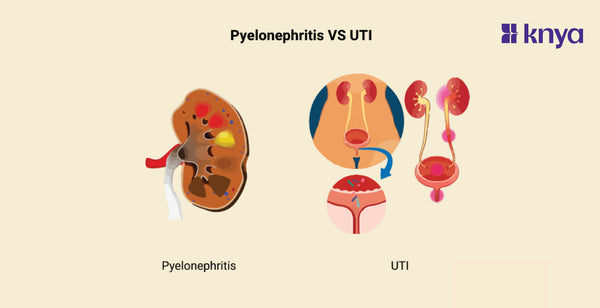Difference between Pyelonephritis and Urinary Tract Infections (UTIs): Urinary Tract Infections (UTIs) and Pyelonephritis are both bacterial illnesses that affect the urinary system, but their severity and location vary. UTIs can affect any section of the urinary system, including the bladder, urethra, or ureters, and are often accompanied by symptoms like urine frequency, urgency, and dysuria. Pyelonephritis, on the other hand, is a kidney-specific infection that frequently develops as a result of untreated or poorly managed UTIs. Pyelonephritis symptoms include fever, flank discomfort, nausea, and vomiting, in addition to the classic UTI indicators. While UTIs are typically less severe and can be treated with oral antibiotics, pyelonephritis may necessitate hospitalization for IV antibiotics and supportive care to avoid complications such as kidney abscess or sepsis.
[image_banner]
Difference between Pyelonephritis and Urinary Tract Infections(UTI)
Pyelonephritis and Urinary Tract Infections (UTIs) are bacterial infections of the urinary system but differ in severity and location. The table below provides the differences between Pyelonephritis and Urinary Tract Infections (UTIs).
|
Feature |
Pyelonephritis |
Urinary Tract Infections (UTIs) |
|
Definition |
Bacterial infection of the kidneys. |
Bacterial infection affecting any part of the urinary tract, including bladder, urethra, or ureters. |
|
Location |
Specifically targets the kidneys. |
Can affect any part of the urinary tract, including bladder, urethra, or ureters. |
|
Severity |
Typically more severe, may require hospitalization. |
Often less severe, can often be treated on an outpatient basis. |
|
Symptoms |
Fever, chills, flank pain, nausea, vomiting, frequent urination, dysuria, cloudy or foul-smelling urine. |
Urinary urgency, frequency, dysuria, cloudy or foul-smelling urine, low-grade fever. |
|
Complications |
Kidney abscess, sepsis, long-term kidney damage. |
Recurrent infections, progression to pyelonephritis, long-term kidney damage. |
|
Diagnostic tests |
Urinalysis, urine culture, imaging studies (ultrasound, CT scan). |
Urinalysis, urine culture. |
|
Treatment |
Antibiotics may require hospitalization for intravenous antibiotics. |
Antibiotics, typically on an outpatient basis. |
|
Prevention |
Prompt treatment of UTIs, good hygiene practices. |
Hydration, good hygiene practices, urination after sexual activity. |
Browse The Best Scrubs Collection!
What is Pyelonephritis?
Pyelonephritis is a bacterial infection that affects the kidney parenchyma and pelvis. It is typically caused by bacteria climbing from the lower urinary system to the kidneys. Escherichia coli, Proteus mirabilis, and Klebsiella pneumoniae are some of the most common pathogens. Pyelonephritis can cause inflammation, swelling, and damage to kidney tissue, resulting in fever, chills, flank pain, nausea, vomiting, and urine symptoms such as frequent urination and dysuria.
Features of Pyelonephritis
- Imaging findings: Ultrasound, computed tomography (CT), and magnetic resonance imaging (MRI) can reveal symptoms of kidney inflammation, such as enlargement, edema, or the presence of renal abscesses.
- Complications: If not treated or managed properly, pyelonephritis can cause renal abscess formation, sepsis, renal scarring, and chronic kidney disease.
- Recurrent infections: Some people have pyelonephritis regularly, particularly if they have underlying risk factors such as urinary tract abnormalities or immunodeficiency.
- Systemic symptoms:Patients may experience systemic symptoms such as malaise, weariness, and weakness, which indicate the existence of an acute infectious process.
- Laboratory Tests: Laboratory results may include leukocytosis (an increased white blood cell count), pyuria (the presence of white blood cells in the urine), bacteriuria (the presence of bacteria in the urine), and raised inflammatory markers such as C-reactive protein (CRP) and erythrocyte sedimentation rate (ESR).
Causes of Pyelonephritis
- Escherichia coli: Escherichia coli (E. coli) is the most prevalent bacterium that causes pyelonephritis, accounting for the vast majority of cases. It often starts in the gastrointestinal system and spreads via the urinary tract to infect the kidneys.
- Other Enterobacteriaceae: Pyelonephritis can be caused by bacteria such as Klebsiella pneumoniae, Proteus mirabilis, and Enterobacter species, especially in those with anatomical anomalies or urinary tract blockage.
- Structural Abnormalities: Anatomical abnormalities of the urinary tract, such as kidney stones, strictures, or congenital defects, might increase the risk of urine stasis and bacterial colonization, resulting in Pyelonephritis.
- Catheterization: Indwelling urinary catheters increase the risk of Pyelonephritis because they allow bacteria to enter the bladder and kidneys.
- Catheter Use: Indwelling urinary catheters allow microorganisms to enter the bladder and kidneys, increasing the risk of infection.
- Compromised Immune System: Diabetes, HIV/AIDS, and immunosuppressive medication all compromise the immune system, making it more vulnerable to bacterial infections.
- Vesicoureteral Reflux: Vesicoureteral reflux is a disorder in which urine runs backward from the bladder into the ureters, raising the risk of kidney infection.
Symptoms of Pyelonephritis
- Fever: Pyelonephritis is characterized by a high fever, usually exceeding 38°C (100.4°F), which may be accompanied by chills and rigors.
- Flank Pain: Patients with Pyelonephritis frequently suffer unilateral or bilateral flank discomfort, which can be subtle or acute and spread to the back or groin.
- Nausea and vomiting: Pyelonephritis is characterized by gastrointestinal symptoms such as nausea and vomiting, which are frequently accompanied by a loss of appetite.
- Urinary Symptoms: Urinary symptoms of Pyelonephritis include urgency, frequency, dysuria (painful urination), and hematuria.
- Pyelonephritis: Pyelonephritis is distinguished by discomfort at the costovertebral angle (placed between the lower ribs and the spine).
- Systemic Symptoms: Patients may have systemic symptoms such as malaise, weariness, and weakness.
- Other symptoms: In severe cases or when problems arise, patients may have confusion, lethargy, hypotension, and indicators of sepsis.
[image_banner]
What is UTI?
A Urinary Tract Infection (UTI) is a bacterial infection that can occur anywhere in the urinary tract, including the kidneys, ureters, bladder, and urethra. UTIs are one of the most common types of bacterial infections, affecting people of all ages, though they are more prevalent in women.UTIs are typically caused by bacteria, most notably Escherichia coli (E. coli), which live in the gastrointestinal tract and enter the urinary tract via the urethra. Other bacteria, including Klebsiella pneumoniae, Proteus mirabilis, and Enterococcus species, can cause UTIs.
Features of UTI
- Systemic Symptoms: Systemic symptoms include a high fever (over 38°C/100.4°F), chills, lethargy, malaise, and weakness.
- Flank Pain: Pain or discomfort in the lower back or flanks, typically on one side.
- Gastrointestinal Symptoms: Gastrointestinal symptoms include nausea, vomiting, and loss of appetite.
- Urinary Symptoms: Symptoms of lower UTI may also be present, including dysuria and urinary urgency.
- Costovertebral Angle Tenderness: Tenderness at the costovertebral angle (CVA) indicates renal inflammation.
- Urine Retention or Incomplete Voiding: In some situations, UTIs cause urine retention or partial voiding, which can contribute to symptoms such as urinary urgency and frequency.
Causes of UTI
- Female Anatomy: Women have a shorter urethra, which makes it easier for bacteria to enter the bladder.
- Urinary Tract Abnormalities: Structural abnormalities such as kidney stones or urethral strictures can restrict urine flow and raise the risk of UTIs.
- Catheter Use: Indwelling urinary catheters provide a direct conduit for germs to enter the bladder, which can result in catheter-associated UTIs.
- Compromised Immune Function:Diabetes, HIV/AIDS, and immunosuppressive medication all hurt the immune system's ability to combat microorganisms.
- Urinary Retention: The risk of bacterial growth increases when the bladder is not completely emptied due to disorders such as benign Prostatic Hyperplasia (BPH) or neurogenic bladder.
Symptoms of UTI
- Urinary Urgency: A strong and abrupt desire to urinate, frequently with little notice.
- Urinary Frequency: Urinary Frequency refers to the need to urinate more frequently than usual, even when the bladder is not full.
- Dysuria: It is characterized by pain or discomfort during urinating, which might seem like a burning feeling.
- Hematuria: Hematuria refers to the presence of blood in urine, which can appear pink, red, or cola-colored.
- Cloudy or Foul-Smelling Urine: Urine that is cloudy or has an unpleasant odor Changes in urine color or odor suggest the presence of bacteria or pus.
- Pelvic Discomfort: This refers to pain or pressure in the lower abdomen or pelvis.
- Flank Pain: Flank pain is pain or discomfort in the back or side that may signal kidney involvement (Pyelonephritis).
Shop Best Lab Coats From Here!
Similarities between Pyelonephritis and Urinary Tract Infections(UTI)
- Bacterial Infection: Both Pyelonephritis and UTIs are caused by gram-negative bacteria such as Escherichia coli (E. coli), although other pathogens can also be involved.
- Urinary Symptoms: Both disorders can cause dysuria (painful urination), urinary urgency and frequency, and hematuria (blood in the urine).
- Flank Pain: Pyelonephritis and severe UTIs can produce flank pain, discomfort, or tenderness in the lower back or sides, particularly near the kidneys.
- Fever: Both Pyelonephritis and UTIs can cause fever, especially when the upper urinary system is involved.
- Nausea and vomiting: Nausea and vomiting are gastrointestinal symptoms that can occur with both Pyelonephritis and severe UTIs.
- Risk Factors: Certain risk factors include feminine gender, urinary tract abnormalities, and impaired immunological function.
In summary, Pyelonephritis is a severe form of Urinary tract infection (UTI) specifically affecting the kidneys. It presents with symptoms such as high fever, flank pain, nausea, and vomiting, and can lead to complications such as kidney abscesses and sepsis. Prompt diagnosis and treatment with antibiotics, often requiring hospitalization, are essential to prevent long-term kidney damage. On the other hand, UTI is a broader term encompassing infections anywhere in the urinary tract, including the bladder and urethra. While UTIs can cause discomfort and inconvenience, they are generally less severe than pyelonephritis and can often be managed with oral antibiotics on an outpatient basis. However, both conditions require timely intervention to prevent complications and ensure proper recovery.
Order the Best Jogger Scrub From Here!
| Check out More Articles | |
| Difference Between Cartilage and Bone | |
| Difference Between Endocrine and Exocrine Glands | |
| Difference Between Cell Wall and Cell Membrane | |















